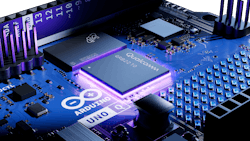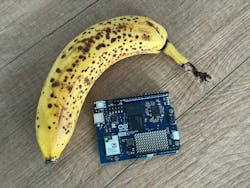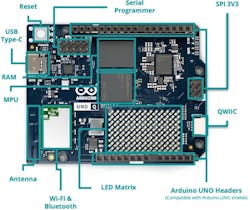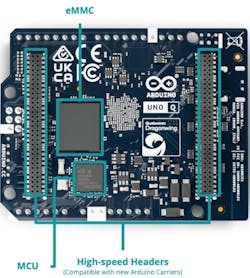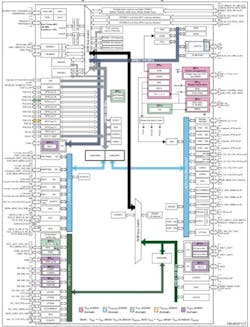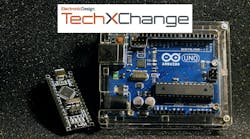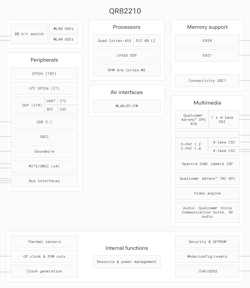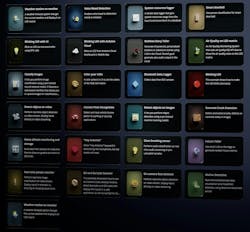Qualcomm’s Acquisition of Arduino Creates a New Vibe—AI and Signal Processing on the UNO Q
What you’ll learn:
- Arduino is being acquired by Qualcomm subject to regulatory approval for an undisclosed sum.
- Qualcomm Arduino introduces a new UNO form factor board, the Arduino UNO Q, which features both a STM32 MCU and a Qualcomm Dragonwing MPU.
- An STM32 MCU coupled with Qualcomm Dragonwing’s AI acceleration, quad-core CPU, Adreno GPU, and dual ISP support turn UNO Q into a compact, cost-effective platform for robotics, IoT, and edge AI.
San Diego-based Qualcomm, today, announced they’re acquiring Arduino, the Italian company that’s renowned among Makers and product developers for their line of ready-to-use Open Source controller/processor boards. More importantly, though, it’s an Open Source company philosophy that provides a rich set of coding libraries and applications that work seamlessly within Arduino’s IDE (integrated development environment).
So, Qualduino? Ardcomm? No — Qualcomm has expressed assurances that Arduino will run business-as-usual and are free to choose the devices that go into future Arduino hardware designs.
Obviously born out of the new alliance, Arduino has now gone public with a new UNO form-factor board, the Arduino Uno Q (Fig. 1), banana for scale as an exclusive to Electronic Design.
“Arduino UNO Q combines high-performance computing and precise real-time control in one compact board. At its heart is the Qualcomm Dragonwing™ QRB2210 microprocessor (MPU), delivering AI acceleration, graphics, and connectivity alongside a real-time STM32U585 microcontroller (MCU). This unique hybrid design makes UNO Q as versatile as it is powerful: from running Linux® apps to handling robotics tasks, all with the simplicity that Arduino is known for.” —Qualcomm Arduino
Let’s start with the familiar and then work toward the Linux, AI, and vibe coding that’s now on the table.
Arduino UNO Q Board Overview
The UNO Q board is available in the standard UNO family form factor of 68.85 × 53.34 mm. It uses their familiar connector and signal arrangement (Fig. 2), lending compatibility with many legacy Arduino “shields” (aka daughtercards or mezzanine cards/boards).
Note that the STM32 MCU’s GPIO does run at 3.3 V, is 5 V tolerant on most pins, and is both CMOS and TTL compatible. For those designs requiring true 5-V TTL I/O, a 5-V adapter shield is available from such sources as SparkFun Electronics.
The UNO Q’s 5-V input is via USB-C connector at 3A, or it can be supplied via a separate +5-V input pin.
Board features, similar to the Arduino R4 WiFi covered by Electronic Design, include:
- 4× RGB user-controllable LEDs
- 8×13 Blue LED Matrix
- 1× Qwiicconnector voltage 3V3, I2C
- 1× User pushbutton
- JCTL: MPU Remote Debug connector
Interfaces native to the onboard microcontroller (MCU) include:
- I2C/I3C
- SPI
- PWM
- CAN
- UART
- PSSI
- GPIO
- JTAG
- ADC
The back side of the UNO Q (Fig. 3) does have a new set of connectors for the additional I/O and high-speed interfaces, such as cameras, displays, audio, etc. supported by the MCU.
STMicro Microcontroller
The top side of the UNO Q has an STMicro STM32U585 microcontroller, which features an Arm Cortex-M33 running at up to 160 MHz, delivering up to 240 DMIPS, with 1.5 DMIPS/MHz (Dhrystone 2.1) benchmarking (Fig. 4).
For memory, UNO Q’s MCU has 2-MB flash memory with ECC, arranged in two banks to facilitate read-while-write, and includes 512 kB with 100 kcycles of write lifetime. The MCU also packs 786-kB SRAM with ECC OFF or 722-kB SRAM, including up to 322-kB SRAM with ECC ON.
In addition, the STM32 has an external memory interface that supports SRAM, PSRAM, NOR, NAND, and FRAM memories and up to two Octo-SPI memory interfaces.
>>Check out this TechXchange for similar articles
Of concern to any legacy Arduino UNO aficionado, the MCU has up to 136 fast I/Os with interrupt capability, most of which are 5 V tolerant, and up to 14 I/Os with independent supply down to 1.08 V. How these are connected to the UNO-family connector footprint is not available at the time of this writing.
Each of the MCU’s GPIO pins can be configured by software as output (push-pull or open-drain), as input (with or without pull-up or pull-down), or as peripheral alternate function. Most of the GPIO pins are shared with digital or analog alternate functions.
After reset, all GPIOs are in analog mode to reduce power consumption. The I/Os alternate function configuration can be locked if needed following a specific sequence to avoid spurious writing to the I/Os registers.
Given the presence of the 8×13 Blue LED Matrix on the UNO Q board, the GPIO clearly has sufficient source/sink capability for that task. All I/Os are CMOS- and TTL-compliant (no software configuration required). Their characteristics cover more than the strict CMOS or TTL parameters.
Regarding timers, the MCU features two 16-bit advanced motor-control timers; four 32-bit, five 16-bit, four low-power 16-bit (available in Stop mode), two SysTick, and two watchdog timers. A real-time clock (RTC) is available on chip with hardware calendar and calibration.
Worthy of note is an integrated CAN FD controller, two SDMMC interfaces, and a multifunction digital filter (six filters). An audio digital filter with sound-activity detection and a parallel synchronous slave interface (PSSI) is embedded in silicon. The MCU's 16- and 4-channel DMA controllers are also functional in Stop mode.
On the graphics display side, a Chrom-ART Accelerator (DMA2D) has been integrated for enhanced graphic content creation. Video input is supported with a digital camera interface mathematical coprocessor.
For real-time inverse kinematics computations, as found in robotics applications, or for motor control, metering, signal processing, and many other applications, a CORDIC co-processor provides hardware acceleration of certain mathematical functions, notably trigonometric. This speeds up the calculation of these functions compared to a software implementation.
The STM32’s filter mathematical accelerator (FMAC) performs arithmetic operations on vectors. It comprises a MAC (multiplier/accumulator) unit, together with address generation logic that allows it to index vector elements held in local memory. The unit includes support for circular buffers on input and output that makes it possible to implement digital filters; both finite and infinite impulse response filters can be done.
On the analog side, up to 22 capacitive sensing channels support touch key, linear, and rotary touch sensors.
Rich analog peripherals, with an independent analog power supply, include:
- 14-bit ADC 2.5-MSPS with hardware oversampling
- 12-bit ADC 2.5-MSPS, with hardware oversampling, autonomous in Stop 2 mode
- Two 12-bit DACs, low-power sample and hold
- Two operational amplifiers with built-in PGA
- Two ultra-low-power comparators
The MCU runs a real-time operating system (RTOS) with Arduino Core on a Zephyr OS.
Microprocessor Unit
The new added capability of the Arduino UNO Q is largely due to the presence of a second processing unit, the Qualcomm Dragonwing QRB2210 (Fig. 5), which provides AI acceleration, a quad-core CPU, an Adreno GPU, and dual ISP support.
More specifically, the Dragonwing features:
- Quad-core Arm Cortex-A53 @ 2.0 GHz
- Adreno GPU 3D graphics accelerator
- 2x ISP (13 MP + 13 MP or 25 MP) @ 30 fps
- RAM: 2GB LPDDR4 (4-GB variant available year-end 2025)
- Storage: 16-GB eMMC (32-GB variant available year-end 2025)
- Connectivity:
- Wi-Fi 5 2.4/5GHz with onboard antenna
- Bluetooth 5.1 with onboard antenna
- Camera:
- USB camera support
- 2× MIPI CSI pins on JMEDIA header
- Display:
- Video output support via USB-C
- MIPI DSI pins on JMEDIA header
- Audio: Microphone IN / Headphone OUT / Line OUT on JMISC
- MPU OS
The Dragonwing runs Linux Debian OS with upstream support and enables the new Arduino IDE to run natively on it, without the need for an external computer system.
IDE
The Arduino UNO Q uses an entirely new IDE that unifies the journey across real-time, Linux, Python, and AI. Though details are sparse at press time, just as with Arduino’s legacy IDE, a rich library of examples (Fig. 6) is provided on an application basis.
“Vibe-coding" is also a rumored capability in the new IDE, where programs are generated by the IDE’s LLM AI for the UNO Q based upon text prompts by, allegedly, inexperienced users. In the hands of experienced developers, the possibility does exist for increased productivity and shorter development times.
The new IDE is available for download, click here.
Summary
The Arduino UNO Q with 2 GB of RAM and 16 GB eMMC is available for order immediately, ships starting October 25, 2025. It’s priced at €39/$44.
The Arduino UNO Q with 4 GB of RAM and 32 GB eMMC is available for order in November 2025, ships by YE2025, and is priced at €53/$59.
For our readers' convenience, the Arduino Q User Manual is available for download here:
An Arduino UNO Q has been requested from Arduino, which will enable Electronic Design to do some tire-kicking to share with readers. Space and time constraints limit more details, so the datasheet for the STM32 and the Dragonwing are available to readers for readers’ convenience to download here:
As always, when embarking on a new design, ensure component availability and download the latest information from the respective manufacturers. More data on the Arduino UNO Q will be added here as it becomes available.
Andy's Nonlinearities blog arrives the first and third Monday Tuesday of every month. To make sure you don't miss the latest edition, new articles, or breaking news coverage, please subscribe to our Electronic Design Today newsletter. Please also subscribe to Andy’s Automotive Electronics bi-weekly newsletter.
>>Check out this TechXchange for similar articles
About the Author
Andy Turudic
Technology Editor, Electronic Design
Andy Turudic is a Technology Editor for Electronic Design Magazine, primarily covering Analog and Mixed-Signal circuits and devices. He holds a Bachelor's in EE from the University of Windsor (Ontario Canada) and has been involved in electronics, semiconductors, and gearhead stuff, for a bit over a half century.
"AndyT" brings his multidisciplinary engineering experience from companies that include National Semiconductor (now Texas Instruments), Altera (Intel), Agere, Zarlink, TriQuint,(now Qorvo), SW Bell (managing a research team at Bellcore, Bell Labs and Rockwell Science Center), Bell-Northern Research, and Northern Telecom and brings publisher employment experience as a paperboy for The Oshawa Times.
After hours, when he's not working on the latest invention to add to his portfolio of 16 issued US patents, he's lending advice and experience to the electric vehicle conversion community from his mountain lair in the Pacific Northwet[sic].
AndyT's engineering blog, "Nonlinearities," publishes the 1st and 3rd monday of each month. Andy's OpEd may appear at other times, with fair warning given by the Vu meter pic.
